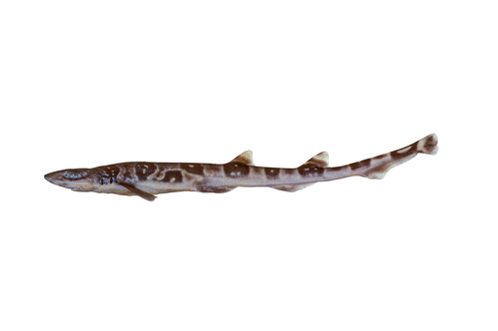Sawtail Catshark, Figaro boardmani (Whitley 1928)
Other Names: Australian Sawtail Catshark, Banded Shark, Sawtail Catshark, Sawtail Shark

Sawtail Catshark, Figaro boardmani. Source: Australian National Fish Collection, CSIRO. License: CC By Attribution-NonCommercial
Summary:
A small pale grey catshark with seven or eight brownish saddle-like blotches across the back (three before the first dorsal fin), interspersed with about eight slightly smaller blotches; inside of mouth dusky.
This species was previously known as Galeus boardmani.
This species was previously known as Galeus boardmani.
Cite this page as:
Bray, D.J. 2017, Figaro boardmani in Fishes of Australia, accessed 06 Jul 2025, https://fishesofaustralia.net.au/Home/species/3749
Sawtail Catshark, Figaro boardmani (Whitley 1928)
More Info
|
Distribution |
Endemic to and widespread in outer continental shelf and upper continental slope waters of the southern half of Australia - from off Brisbane, Queensland, to off Carnavon, Western Australia, and Tasmania. |
|
Features |
Vertebrae: 95-101 (precaudal); 144-160 (total). Body elongate, deepest just behind head; caudal peduncle without keels or precaudal pits. Head conical, flattened slightly above and below; snout relatively long and thick, the tip broadly rounded; nostrils well separated from mouth, not connected to it by groove; eyes large, oval; spiracles moderately small; labial furrows prominent, continuous around mouth corners, extending about one-third of distance to jaw symphysis; teeth alike in both jaws, consisting of one large primary cusp with two or three smaller cusps on each side; five gill slits, fourth over pectoral-fin origin. Denticles on body fine, body not especially rough to touch. Two dorsal fins of similar size, origin of first over axil of ventral fin, origin of second over posterior end of anal-fin base; anal-fin base more than 1.5 times length of first dorsal base; anal and caudal fins widely spaced; caudal fin heterocercal, rather long, upper lobe flared at tip, lower lobe small but distinct, denticles along upper and lower margins of fin noticeably enlarged and saw-like, forming a crest. Pectoral fins broad, with rounded corners, their maximum width greater than mouth width. |
|
Feeding |
Feeds mainly on fishes, crustaceans, and cephalopods. |
|
Biology |
Males mature at about 40 cm TL, and females mature at about 40-43 cm TL. The Sawtail Catshark is oviparous (lays eggs) with one functional ovary in females. Egg cases in several individuals measured 68-74 x 19-21 x 8-9 mm (length x width x depth). The large-yolked eggs are enclosed within a leathery capsule, and are usually attached to the seafloor by tendrils that project from each corner of the capsule. |
|
Fisheries |
Although not targeted, this species is regularly taken as bycatch in various demersal trawl fisheries, and is of minor commercial importance. |
|
Species Citation |
Pristurus (Figaro) boardmani Whitley, 1928, Rec. Aust. Mus. 16(4): 238, pl. 18(3). Type locality: off Montague Island, NSW, ♂. |
|
Author |
Bray, D.J. 2017 |
|
Resources |
Sawtail Catshark, Figaro boardmani (Whitley 1928)
References
Compagno, L.J.V. 1984. FAO Species Catalogue. Sharks of the World. An annotated and illustrated catalogue of shark species known to date. Carcharhiniformes. FAO Fisheries Synopsis No. 125. Rome : FAO Vol. 4(2) 251-655 pp. (as Galeus boardmanii)
Compagno, L.J.V., Dando, M. & Fowler, S. 2005. A Field Guide to the Sharks of the World. London : Collins 368 pp. (as Galeus boardmani)
Compagno, L.J.V. & Niem, V.H. 1998. Families Scyliorhinidae, Proscylliidae. pp. 1279-1292 in Carpenter, K.E. & Niem, V.H. (eds). The Living Marine Resources of the Western Central Pacific. FAO Species Identification Guide for Fisheries Purposes. Rome : FAO Vol. 2 687-1396 pp. (as Galeus boardmanii)
Johnson, J.W. 2010. Fishes of the Moreton Bay Marine Park and adjacent continental shelf waters, Queensland, Australia. pp. 299-353 in Davie, P.J.F. & Phillips, J.A. Proceedings of the Thirteenth International Marine Biological Workshop, The Marine Fauna and Flora of Moreton Bay. Memoirs of the Queensland Museum 54(3)
Kyne, P.M. & Bennett, M.B. (SSG Australia & Oceania Regional Workshop, March 2003) 2003. Figaro boardmani. The IUCN Red List of Threatened Species. Version 2015.1.
Last, P.R. & Stevens, J.D. 1994. Sharks and Rays of Australia. Canberra : CSIRO Australia 513 pp. 84 pls. (as Galeus boardmani)
Last, P.R. & Stevens, J.D. 2009. Sharks and Rays of Australia. Collingwood : CSIRO Publishing Australia 2, 550 pp.
McKay, R.J. 1966. Studies on Western Australian sharks and rays of the families Scyliorhinidae, Urolophidae and Torpedinidae. Journal of the Royal Society of Western Australia 49(3): 65-82 figs 1-6 (as Galeus boardmani)
Springer, S. 1979. A revision of the catsharks, family Scyliorhinidae. National Marine Fisheries Service (U.S.). Technical Report 422: 1-152.
Stead, D.G. 1963. Sharks and Rays of Australian Seas. Sydney : Angus & Robertson 211 pp. 63 figs. (as Galeus boardmani)
Stevens, J.D. 1994. Families Carcharhinidae, Triakidae, Scyliorhinidae. pp. 120-138 figs 76-107 in Gomon, M.F., Glover, C.J.M. & Kuiter, R.H. (eds). The Fishes of Australia's South Coast. Adelaide : State Printer 992 pp. 810 figs. (as Galeus boardmanii)
White, W. 2008. Shark Families Heterodontidae to Pristiophoridae. pp. 32-100 in Gomon, M.F., Bray, D.J. & Kuiter, R.H. (eds). Fishes of Australia's Southern Coast. Sydney : Reed New Holland 928 pp. (as Galeus boardmani)
Whitley, G.P. 1939. Taxonomic notes on sharks and rays. The Australian Zoologist 9(3): 227-262. (as Figaro boardmani socius)
Whitley, G.P. 1940. The Fishes of Australia. Part 1. The sharks, rays, devil-fish, and other primitive fishes of Australia and New Zealand. Sydney : Roy. Zool. Soc. N.S.W. 280 pp. 303 figs. (as Figaro boardmani and Figaro boardmani socius)



